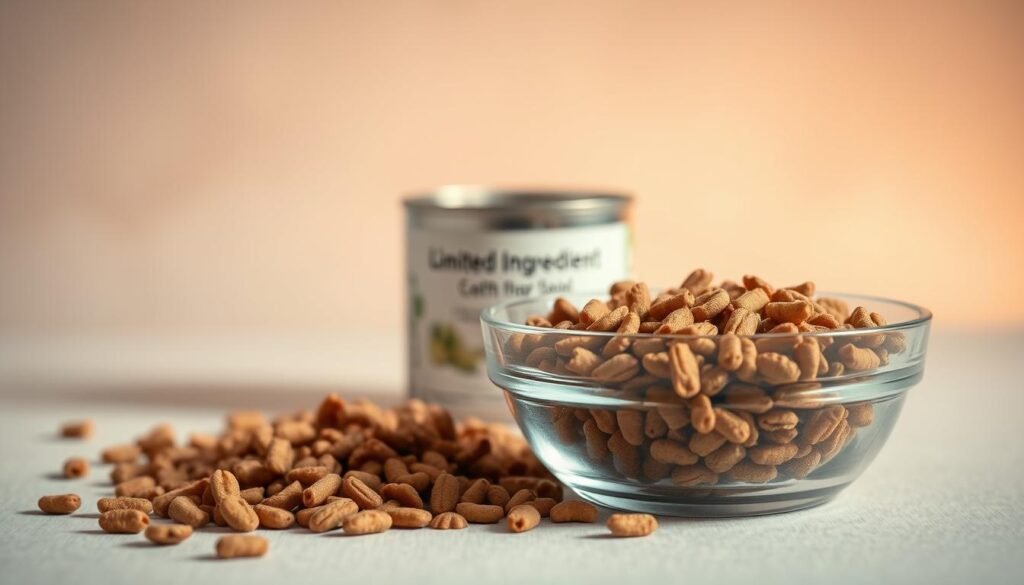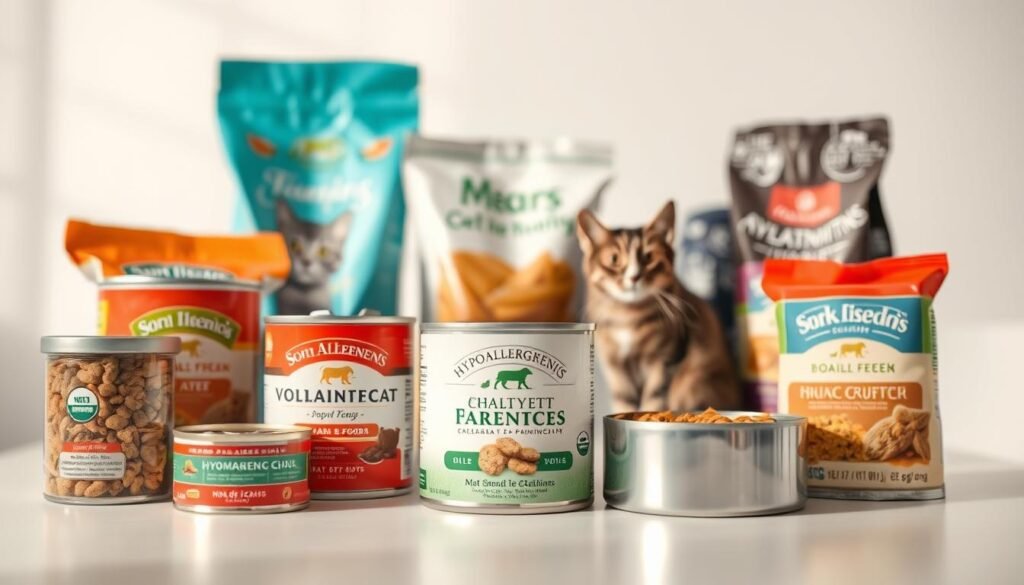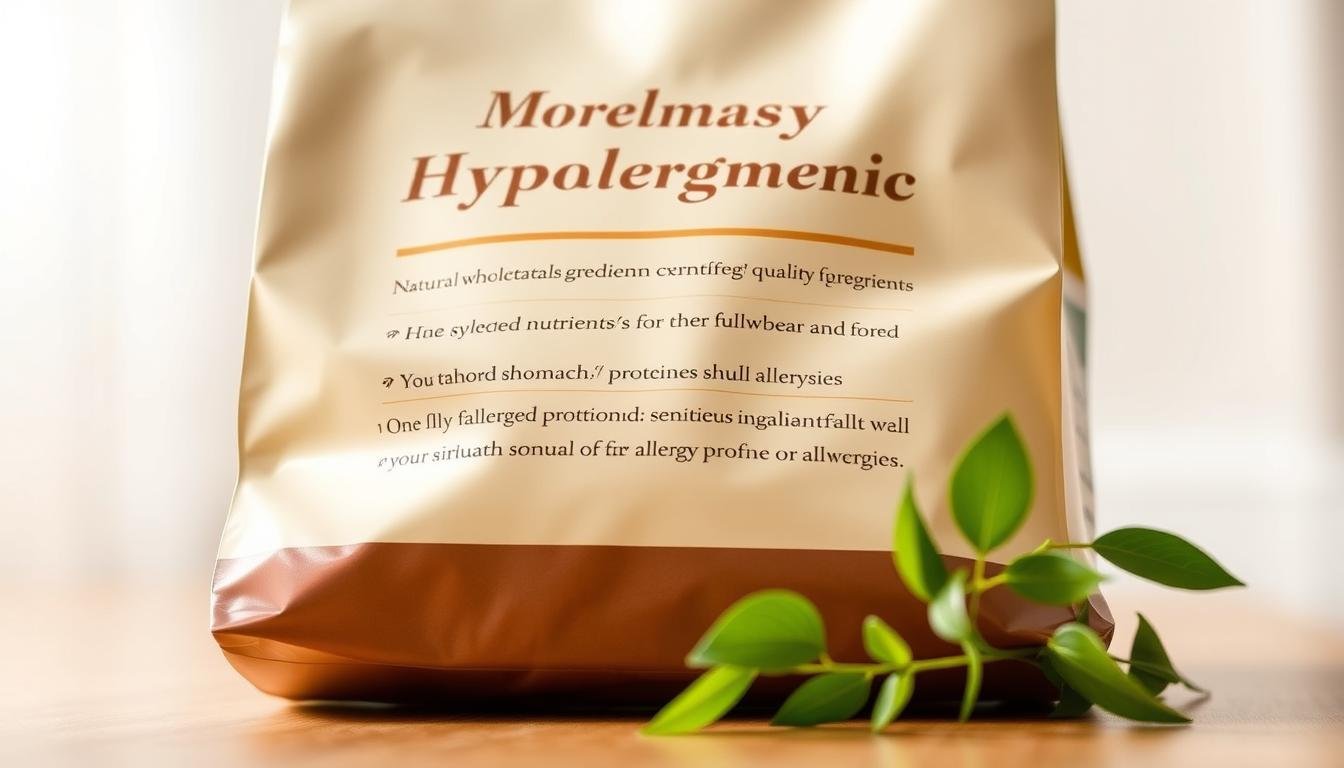Best Cat Food for Allergies: Soothe Your Cat’s Symptoms Fast
Table of Contents
Is your feline friend always scratching or getting skin irritations? Many cat owners struggle to alleviate allergy symptoms in their pets. If your cat is itchy, has skin issues, or stomach problems, it could be diet-related.
Finding the right hypoallergenic cat food is key. With so many choices, picking the best diet for your cat can be tough. This article will guide you to the best cat food for allergies. We aim to help you make a smart choice and enhance your cat’s life.
Understanding Cat Food Allergies and Sensitivities
Knowing about cat food allergies is key for any cat owner. Cats can react badly to certain foods, causing them discomfort and health problems.
The Difference Between Food Allergies and Food Intolerances
Food allergies in cats are an immune reaction to a specific protein. Food intolerances, on the other hand, are about digestive issues and don’t involve the immune system. It’s important to know the difference for the right treatment.
Common Symptoms of Food Allergies in Cats
Symptoms can vary but often include itching, skin irritation, hair loss, and stomach problems like vomiting and diarrhea. These symptoms can be hard to diagnose and distressing for your cat.
| Symptom | Description |
|---|---|
| Itching and Skin Irritation | Can lead to excessive scratching and skin lesions |
| Gastrointestinal Issues | Vomiting and diarrhea are common manifestations |
| Hair Loss | Can occur due to excessive scratching or skin conditions |
How Food Allergies Develop in Cats
Food allergies happen when a cat’s immune system reacts to a specific ingredient, like chicken, beef, or fish. Repeated exposure to the allergen can make the problem worse.
Identifying and managing food allergies is crucial for your cat’s health. By understanding the causes and symptoms, you can work with your vet to find a good diet.
Common Allergens in Commercial Cat Foods
Commercial cat foods often have ingredients that can cause allergies in cats. Knowing these allergens is key for cat owners who think their pets have food allergies.
Protein Allergens
Ingredients like chicken, beef, and fish are common in cat food. They can make some cats sick, causing skin problems and digestive issues.
Dairy Products and Eggs
Dairy products and eggs are also found in cat food. They can be good for cats but may cause allergic reactions in some.
Grains and Gluten
Grains and gluten can also cause problems for some cats. This is why grain-free diets are popular, to avoid these allergies.
Artificial Additives and Preservatives
Artificial additives and preservatives in cat food can make allergies worse. Choosing foods with natural preservatives is better for cats with sensitivities.
To better understand the common allergens, let’s look at a comparison:
| Allergen Type | Common Ingredients | Potential Symptoms |
|---|---|---|
| Protein Allergens | Chicken, Beef, Fish | Skin irritation, digestive issues |
| Dairy and Eggs | Milk, Eggs | Allergic reactions, skin problems |
| Grains and Gluten | Wheat, Corn, Gluten | Digestive issues, skin irritation |
| Artificial Additives | Preservatives, Colors | Allergic reactions, health issues |
For cats with allergies, switching to a limited ingredient cat food or grain-free cat food can help. Always talk to your vet to find the best diet for your cat.
How to Identify If Your Cat Has Food Allergies
Cats can develop allergies to their food. Spotting these allergies needs watching your cat and getting help from a vet. Food allergies in cats show up in different ways, so knowing the signs and how to check for them is key.
Observable Symptoms and Warning Signs
Signs of food allergies in cats include itching, skin problems, and stomach issues. You might see your cat scratching, licking, or chewing at their skin a lot. This can cause irritation and infections. Stomach problems can be diarrhea or vomiting.
When to Consult Your Veterinarian
If your cat shows these symptoms for a long time, see a vet. They can figure out if it’s a food allergy or something else. Getting help early is important for your cat’s health.
Diagnostic Methods
Figuring out food allergies involves trying a special diet. This means feeding your cat a new protein for 8-12 weeks to see if symptoms get better. Sometimes, blood tests are used too.
Differentiating Food Allergies from Environmental Allergies
It’s important to tell food allergies from environmental ones because treatments are different. Your vet can help you figure this out. Choosing the best cat food for cats with allergies or natural cat food for allergies is a big step in helping your cat.
By working with your vet and watching your cat’s signs, you can find out if they have a food allergy. Then, you can take steps to manage it.
Best Cat Food for Allergies: What to Look For
Choosing the right cat food for allergies is important. Your cat’s diet affects their allergies. Making a good choice can greatly improve their life.
Key Ingredients to Seek Out
Look for cat foods with novel proteins like venison, duck, and salmon. These are less likely to cause allergies. Also, grain-free and limited ingredient diets are good because they have fewer allergens.
Omega-3 fatty acids are also key. They help reduce inflammation and keep the skin healthy. Look for fish oil or flaxseed in the food.
Ingredients to Avoid
It’s just as important to know what to avoid. Avoid beef, dairy, and chicken if your cat is allergic. Also, steer clear of artificial additives and preservatives as they can make allergies worse.
Reading and Understanding Cat Food Labels
Reading cat food labels is crucial. Look for clear protein sources and fewer ingredients. Avoid vague terms like ‘meat’ or ‘by-products’ and choose named proteins instead.
Understanding labels also means knowing about manufacturing. Foods made in clean facilities are less likely to have allergens.
Quality Indicators in Allergy-Friendly Foods
Quality allergy-friendly cat foods use named protein sources and avoid fillers and artificial preservatives. They also have clear manufacturing processes. Trust brands that share this information.
| Feature | Ideal Choice | What to Avoid |
|---|---|---|
| Protein Source | Novel proteins (venison, duck, salmon) | Common proteins (chicken, beef, dairy) |
| Grains | Grain-free or limited ingredient | Multiple grains (wheat, corn, soy) |
| Additives | Natural preservatives (Vitamin E) | Artificial preservatives (BHA, BHT) |
Hypoallergenic Cat Food Options
If your cat has food allergies, hypoallergenic cat food can be a big help. These foods are made to lower the risk of an allergic reaction. They are great for cats with sensitivities.
What Makes a Food Truly Hypoallergenic
A hypoallergenic cat food uses ingredients that are less likely to cause allergies. It often includes novel protein sources or hydrolyzed protein formulas. Novel proteins are new to your cat, so they’re less likely to cause an immune response.
Novel Protein Sources
Novel proteins like venison, duck, and rabbit are used in hypoallergenic cat foods. They are less common than chicken or beef. This makes them a good choice for cats with food allergies.
Hydrolyzed Protein Formulas
Hydrolyzed protein formulas break down proteins into smaller pieces. This makes them less likely to cause an allergic reaction. The process uses enzymes to break down the proteins into smaller sizes that the cat’s immune system doesn’t recognize.
Top Hypoallergenic Brands and Products
Top brands for hypoallergenic cat food include Hill’s Prescription Diet and Royal Canin. They offer many formulas for cats with different allergies. Always talk to your vet to find the best food for your cat.
Limited Ingredient Cat Food for Sensitive Stomachs
Limited ingredient cat food is made for cats with sensitive stomachs. It has fewer ingredients to help manage food reactions. This makes it easier to find and avoid allergens.
Simplifying Your Cat’s Diet
These diets have only one protein source and a few carbs. This reduces the chance of bad reactions. It also helps find the cause of an allergy.
Benefits for Cats with Multiple Sensitivities
Cats with many food sensitivities do well on limited ingredient diets. These diets cut down on allergens. They also help manage symptoms of food allergies.

Popular Limited Ingredient Brands
Many brands offer top-notch limited ingredient cat food. Natural Balance and Blue Buffalo are favorites. They use quality, easy-to-digest ingredients.
| Brand | Protein Source | Key Features |
|---|---|---|
| Natural Balance | Salmon, Lamb | Grain-free, Limited ingredient list |
| Blue Buffalo | Duck, Salmon | High-quality protein, Antioxidant-rich |
| Merrick | Real Meat, Fish | Grain-free, No artificial preservatives |
Success Stories and Case Studies
Many cat owners have seen big improvements with limited ingredient diets. Their cats’ symptoms get better. This shows how simple diets can manage allergies and sensitivities.
Choosing limited ingredient cat food is a smart move. It helps manage your cat’s sensitivities and boosts their health.
Grain-Free Cat Food: Benefits and Considerations
Grain-free cat food is a good choice for cats with sensitivities. It removes common allergens like wheat, corn, and soy. This can help reduce allergic reactions in sensitive cats.
How Grain-Free Formulas Help Allergic Cats
Grain-free cat foods are great for cats with grain allergies or intolerances. They remove grains, which can help with itching, digestive issues, and skin problems.
Potential Concerns with Grain-Free Diets
Grain-free diets might be good, but they could also harm a cat’s heart. The FDA is looking into a link between grain-free foods and heart problems in cats. But, they don’t know the exact cause yet.
FDA Guidance on Grain-Free Foods
The FDA says cat owners should talk to their vets before changing their cat’s diet. They want to make sure grain-free diets are balanced and have all the nutrients cats need.
Best Grain-Free Options for Allergic Cats
When picking grain-free cat food, look for new protein sources and avoid artificial stuff. Here are some important things to consider:
| Brand | Protein Source | Key Features |
|---|---|---|
| Merrick | Real Salmon | Grain-free, no artificial preservatives |
| Taste of the Wild | Real Roasted Turkey | High-protein, grain-free formula |
| Blue Buffalo | Deboned Chicken | LifeSource Bits for immune support |
Choosing a balanced, grain-free cat food and talking to your vet can help manage your cat’s allergies well.
Wet vs. Dry Cat Food for Allergies
Choosing the right cat food for allergies is a big decision. You have to think about the good points of wet food and dry food. The best choice depends on what your cat needs.
Advantages of Wet Food for Allergic Cats
Wet cat food is great for cats with allergies because it’s very moist. This helps keep your cat hydrated and can prevent some health problems. It also has fewer carbs and is less processed than dry food, which can help avoid bad reactions.
Benefits of Dry Food Formulations
Dry cat food has its own pluses. It’s easy to store and serve, and it helps keep your cat’s teeth clean. Some dry foods also have special ingredients that help with skin and coat health, which is good for allergic cats.
Combining Both for Optimal Nutrition
Some cat owners mix wet and dry food for their allergic cats. This way, they get the benefits of both: more moisture and better dental health. Always watch how your cat reacts to new foods and make changes as needed.
Moisture Content and Digestibility Factors
Wet food is often more appealing and easier to digest for cats, especially those with sensitive stomachs. But, dry food is better for cats that need convenience and dental care. The choice should be based on what your cat needs and their health.
Prescription and Veterinary Cat Food for Severe Allergies
If your cat’s allergies are hard to manage, a prescription diet might be the solution. Cats with severe food allergies often need more than what you can buy over the counter. In these cases, food prescribed by a vet can be a tailored solution.
When Over-the-Counter Options Aren’t Enough
Cats with extreme sensitivities need special diets to avoid allergic reactions. Veterinary cat food is made to meet these needs. It often helps when other foods don’t.
Popular Veterinary Prescription Diets
Some brands are experts in hypoallergenic cat food for severe allergies. Hill’s Prescription Diet and Royal Canin are well-known for their veterinary-prescribed formulas. These diets are made with vet and nutritionist input to ensure they’re right for cats with severe allergies.

Cost Considerations and Insurance Coverage
Prescription cat foods might cost more than regular foods, but they’re often worth it for cats with severe allergies. Some pet insurance plans may help cover the cost. It’s a good idea to check with your provider.
Working with Your Vet to Find the Right Formula
Talking to your vet is key in finding the right food for your cat’s allergies. They can guide you through the options. They’ll suggest the best hypoallergenic cat food for your cat’s needs.
Transitioning Your Cat to a New Allergy-Friendly Diet
Switching to a new cat food is key for cats with allergies. It helps prevent bad reactions. Make sure to change their diet slowly to avoid stomach problems.
Creating a Gradual Transition Plan
Begin by adding a little of the new food to their old food. Slowly increase the new food over 7-10 days. This gradual transition lets their stomach get used to the new food.
Dealing with Picky Eaters
Some cats don’t like new foods. If your cat is picky, try warming the new food. Or mix it with a bit of tasty liquid, like low-sodium chicken broth.
Monitoring for Improvement or New Reactions
Watch your cat closely during the change. Look for better allergy symptoms and any new issues with the new food. A vet says, “Changing diets needs patience and watching closely.”
“A successful diet change requires patience and observation.”
Timeline Expectations for Symptom Relief
It might take time to see big changes in your cat’s allergies. Usually, you’ll see improvements in a few weeks after switching.
By following these steps and watching your cat’s reaction, you can make the switch to a better cat food smoothly.
Homemade and Raw Diets for Cats with Allergies
Homemade and raw diets can be a big help for cats with allergies. They offer a natural and controlled way to feed your cat. By making your cat’s meals at home, you can skip common allergens in commercial foods. You can also make sure the diet fits your cat’s needs perfectly.
Potential Benefits of Home-Prepared Meals
One big plus of homemade diets is choosing ingredients with care. This way, you can avoid allergens and make sure your cat gets the nutrients they need. Many cat owners have seen their pets’ allergy symptoms get better after switching to homemade food.
Essential Nutritional Considerations
When making homemade food for your cat, it’s key to make sure it’s balanced. Cats need certain amino acids, vitamins, and minerals. A well-thought-out homemade diet can give these, but it needs careful planning.
Some important things to think about include:
- Getting enough protein from animal sources
- Adding essential fatty acids for skin and coat health
- Making sure there are enough vitamins and minerals
Working with a Veterinary Nutritionist
To make sure your homemade diet is complete, talk to a veterinary nutritionist. They can help you create a diet that fits your cat’s needs. They’ll consider your cat’s age, health, and allergies.
Safety Concerns and Proper Food Handling
When making homemade cat food, it’s vital to handle it safely. This means storing, handling, and preparing it right to avoid bacteria. This keeps your cat’s food safe and healthy.
By carefully planning a homemade or raw diet, you can help manage your cat’s allergies. This can greatly improve their health and happiness.
Conclusion: Creating a Sustainable Feeding Plan for Your Allergic Cat
Creating a good feeding plan for your allergic cat means picking the right food, transitioning slowly, and watching for changes. Working with your vet is key to making your cat more comfortable. Look for hypoallergenic cat food that avoids common allergens.
Dealing with food allergies in cats takes time and effort. You might need to try different foods to find the best one. Stay patient and keep asking for help from your vet.
By following the advice in this article and talking to your vet, you can make a feeding plan that’s right for your cat. The right food can make your cat’s life better and happier.

